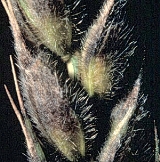
Phaeosphaeria nodorum
Encyclopedia
Phaeosphaeria nodorum is a major fungal pathogen of wheat (Triticum aestivum) and a member of the Dothideomycetes
, a large fungal taxon that includes many important plant pathogens affecting all major crop plant families.
The Dothideomycetes is a newly recognised major class of filamentous fungi that replaces the long-recognized loculoascomycetes. It includes the causal organisms of many economically important plant diseases.
The infection occurs in repeated cycles of both asexual and sexual infection throughout the growing season. New rounds of infection are initiated by rain-splash or wind dispersal of spores. Infection begins when spores land on leaf tissue. The spores rapidly germinate to produce long, branching threadlike structures, called hyphae. The hyphae invade the leaf, using specialised branches to gain entry to the outermost layer of cells on the leaves. They can also grow directly through pores in the leaves. The hyphae rapidly colonize the leaves and begin to produce asexual fruiting bodies.
Phaeosphaeria nodorum is an experimentally tractable organism, which is easily handled in defined media. It was one of the first fungal pathogens to be genetically manipulated. Phaeosphaeria nodorum has been a model for fungicide development and emerged as a model for dothideomycete pathology.
Phaeosphaeria nodorum has been sequenced and annotated by the Broad Institute.
Dothideomycetes
Dothideomycetes is the largest and most diverse class of ascomycete fungi. It comprises 11 orders 90 families, 1300 genera and over 19,000 known species. Traditionally, most of its members were included in the loculoascomycetes, which is not part of the currently accepted classification...
, a large fungal taxon that includes many important plant pathogens affecting all major crop plant families.
The Dothideomycetes is a newly recognised major class of filamentous fungi that replaces the long-recognized loculoascomycetes. It includes the causal organisms of many economically important plant diseases.
The infection occurs in repeated cycles of both asexual and sexual infection throughout the growing season. New rounds of infection are initiated by rain-splash or wind dispersal of spores. Infection begins when spores land on leaf tissue. The spores rapidly germinate to produce long, branching threadlike structures, called hyphae. The hyphae invade the leaf, using specialised branches to gain entry to the outermost layer of cells on the leaves. They can also grow directly through pores in the leaves. The hyphae rapidly colonize the leaves and begin to produce asexual fruiting bodies.
Phaeosphaeria nodorum is an experimentally tractable organism, which is easily handled in defined media. It was one of the first fungal pathogens to be genetically manipulated. Phaeosphaeria nodorum has been a model for fungicide development and emerged as a model for dothideomycete pathology.
Phaeosphaeria nodorum has been sequenced and annotated by the Broad Institute.

